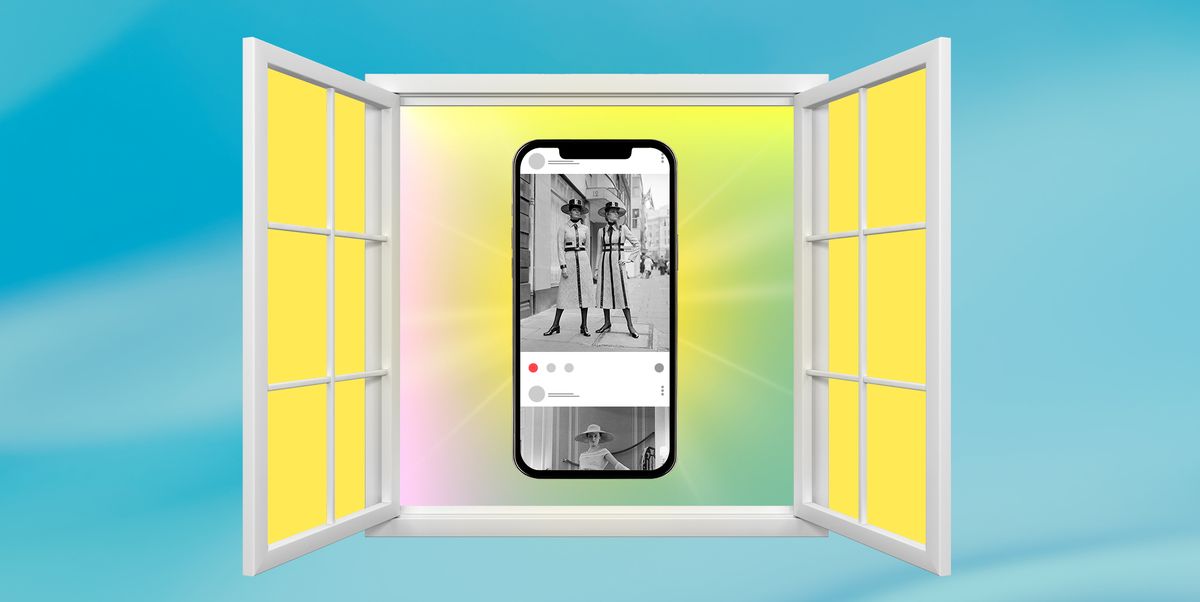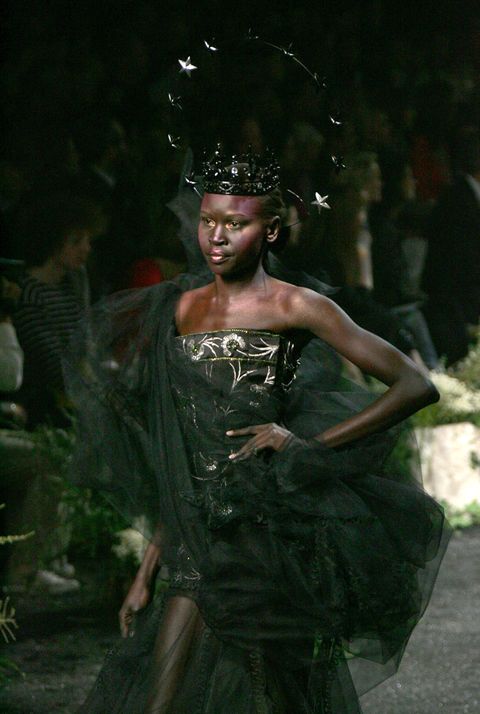Collages of posters, magazine clippings, and Polaroids that often plastered the walls of teenage bedrooms in the aughts hinted at what the younger generation deemed “cool” at the time—most likely, XYZ celebrity, band, movie, artist, or designer. Today, a cohort of digitally-savvy users replicate that very same level of obsession on Instagram via finstas, fan pages, and fervent support. At least that’s what 22-year-old Ketevan Gagoshidze did when she first set up @datewithversace in 2018, an account wholly dedicated to documenting her fascination with the Italian luxury house’s digital memorabilia that she’s collected over the years.
Think: interview clippings featuring pearls of wisdom from founder Gianni Versace himself, editorials from the ‘90s featuring O.G. supermodels like Naomi Campbell and Linda Evangelista repping designs now only available on vintage resale websites, and grainy, yet palpably chic, videos of its fashion shows from a time when livestreams didn’t exist. To populate her feed, Gagoshidze, who’s based in Tbilisi, Georgia, scours the internet high and low for Versace relics that feed her nostalgia for moments that took place before she was even born. “In fashion, you need to know the archive, because it contains a lifetime,” she tells ELLE.com. “Everything new is something old.”
Date with Versace is just one of the many archive accounts on Instagram personifying this throwback-driven sentiment, not just on Thursdays, but year-round. Curated by fashion fans next-door, they are the ‘gram-friendly equivalent of history books that are devoured by digital natives, and, in some cases, insiders from the industry and even the brand itself. Case in point: Date with Versace boasts a sizable following that includes the house and its matriarch, Donatella Versace.
This content is imported from Instagram. You may be able to find the same content in another format, or you may be able to find more information, at their web site.
The only rule is that there are no rules; curators are not obliged to post every day, and they retain complete control over what and when to post. These archive accounts do not rely on paid partnerships or sponsorships with the brand, nor is there any inclination to do so. Basically, each page functions as a digital time capsule built out of pure fondness and zeal.
“If you think about it, [fashion archive accounts] have always been around in some shape or form—on Tumblr, and before that, in scrapbooks and diaries,” says John Matheson, the curator behind @McQueen_Vault, which he describes as a “social collage of Alexander McQueen.” He adds: “Instagram was an obvious evolutionary step, and now it’s even migrating to TikTok. It’s only a matter of time before the current medium in which it exists will evolve; it is a zeitgeist of what is going on at the time.”
While his online tribute only came into being in 2018, Matheson has been an ardent follower of McQueen’s work since 1996, when he first laid his eyes on one of the irreverent British designer’s most prolific shows: Dante. Little did he know that watching this 27-minute showcase on TV would result in multiple trips to the offices of Atlas Magazine and National Geographic to obtain references and press clippings that would allow him to (very) closely dissect McQueen’s breadth of work. Currently, Matheson spends his days sharing the same resources to help higher institutions with their background research. In fact, he consulted on an upcoming exhibition of McQueen’s work at the Los Angeles County Museum of Arts (LACMA), which opened last month.
This content is imported from Instagram. You may be able to find the same content in another format, or you may be able to find more information, at their web site.
To pin McQueen Vault as a gold mine of images to gawk at and then scroll past would diminish the essence of why Matheson began archiving in the first place. “McQueen isn’t just a social media moment or a post for me,” he says matter-of-factly. “He firmly stood for who he was in the industry: a gay man going against the norms. He was very much the underdog and fighting the fight for resistance. Very few possess the emotional magnetism that he does.”
Much like McQueen, many of couture’s trailblazing maestros have since left us. The absence of Thierry Mugler, Virgil Abloh, Albert Elbaz, and Karl Lagerfeld has left an unmistakable void in the industry; forcing us to turn the page on an iconic chapter of what once was. The phrase, “There will never be another one like you” precedes most tributes in their honor, indicating the sheer magnitude of the irreplaceable loss. Perhaps archive accounts unconsciously fill some of that void by memorializing an epoch and its innovator. During a time of loss, they provide a beacon of familiarity and comfort, something to clutch onto in the hurricane of newness that inundates our feeds.
“It’s important for the next generation to know that personalities like Karl Lagerfeld and Lee Alexander McQueen were here,” says Rodrigo Valderrama, stylist and John Galliano enthusiast, who articulates his fashion fandom via @diorinthe2000s. Speaking from Chile, the 24-year-old chuckles over the phone while reflecting on the mundane origins of his account in 2016. “My phone’s memory was at its capacity, mostly thanks to the million images saved of John Galliano’s time at Dior,” he says. “I needed to transfer them elsewhere, so I started posting my archive collection on Instagram. I had no intention of building a narrative, but it just blew up.”
Valderrama admits to not being as active on @diorinthe2000s as he used to be, but refuses to apologize about it. He achieved what he wanted by cementing his love for fashion’s theatrics, particularly through the extravagant lens of John Galliano, in the minds of his 91.9k followers (including Bella Hadid, who’s modeled for the house).
Ryan McMahon, the 25-year-old behind @chanel_archives, takes a similar approach. “I started this platform to give an insight into Chanel’s less covered collections, or the ones that weren’t as accessible as the mid-‘90s shows,” he says. “I find it more engaging when people want to be clued into the brand and aren’t just following to see pretty clothes. Even if you’re not interested in fashion, there’s always something you can take away after watching a Chanel show.”
With fashion’s supersonic evolution and a constant reshuffling of the visionaries at its helm, takeaways today all too easily get swept away with the news cycle, and it’s a challenge to recall or digest the who, what, why, and where of season’s past. “There were certain rhythms with brands that people were familiar with,” Matheson adds. “Especially in the ‘90s, there were so many moments Karl Lagerfeld created for Chanel which have an instant timestamp—you can tell by the belt, the model, the jewelry, the tweed, the music. It packs such a punch and instantly takes you back.”
Archive pages will always serve as a window to the past, but that doesn’t negate their current relevance in a fashion brand’s ever-evolving ecosystem. With their back foot firmly planted in the legacy, and front foot looking toward the future, the act of archiving builds a cultural momentum for the brand in a digital age while simultaneously honoring its roots.
This content is created and maintained by a third party, and imported onto this page to help users provide their email addresses. You may be able to find more information about this and similar content at piano.io

